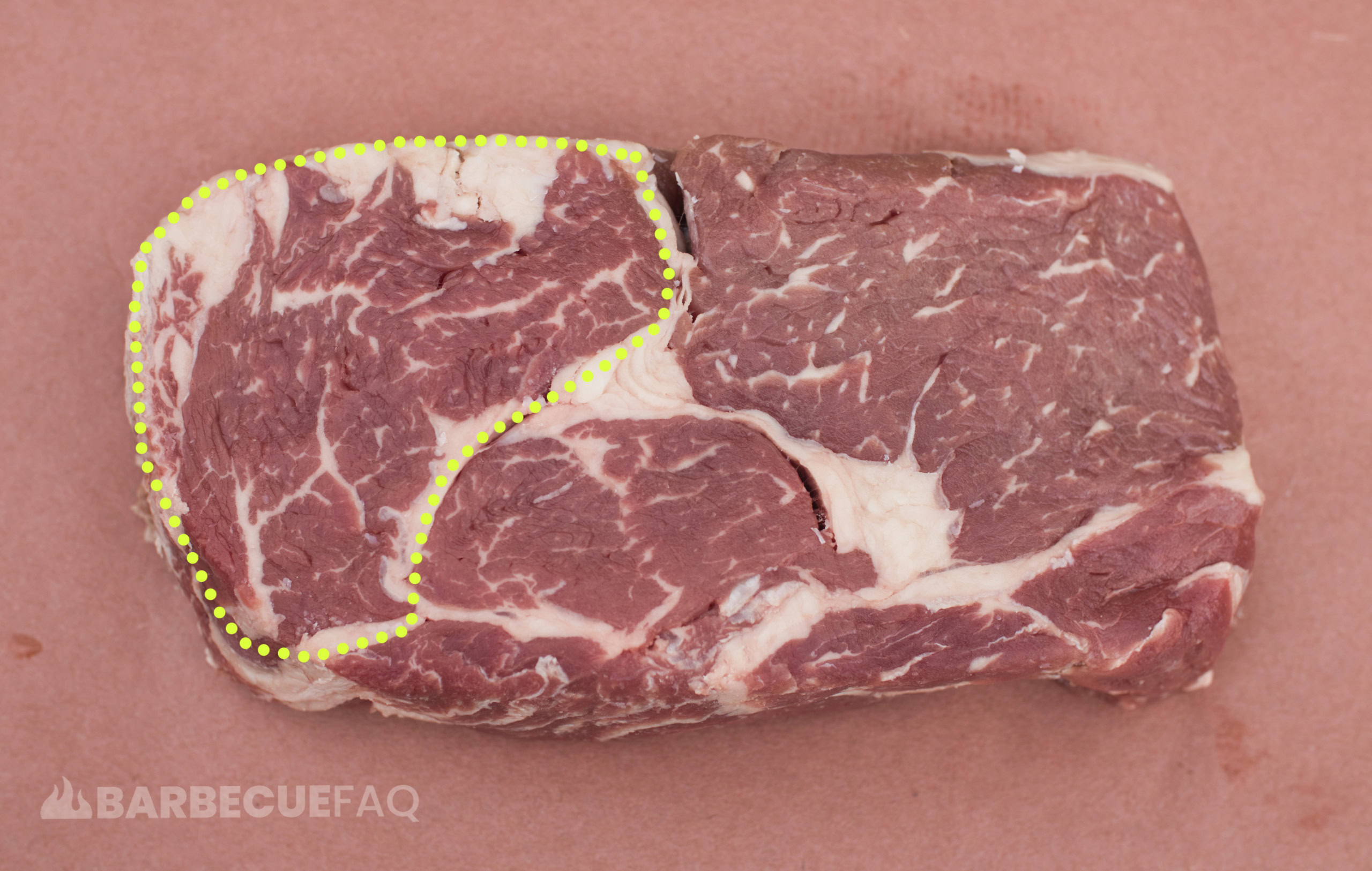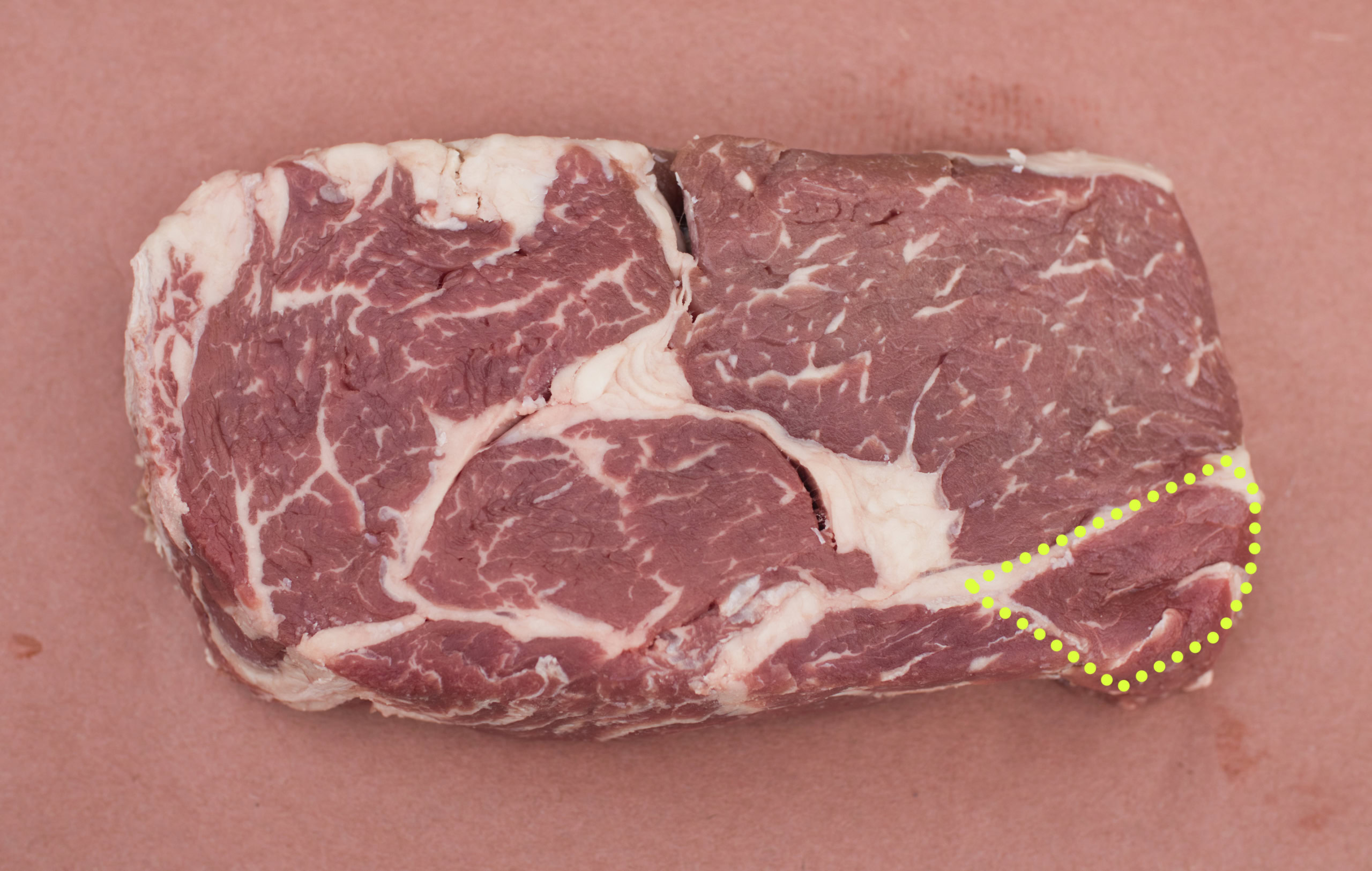If you were to ask people what their favorite cut of steak is, there’s a pretty good chance they’re going to say a Ribeye.
Beef rib steaks are some of the most popular on the entire animal; They’re fatty, but not too fatty; They’re also quite tender when sliced across the grain. They can be thick, thin, bone-in, or boneless.
What is a Rib “Eye” Steak?
To preface this article, it’s important that we define “ribeye” steaks.
Truth be told a true rib “eye” steak only features the center muscle – the eye of the ribeye steak; Scientifically, this is the longissimus dorsi muscle.
This steak is also sometimes referred to as a “ribeye filet.”

Today, the term “ribeye” is more or less used as a way to collectively refer to all rib steaks taken from the rib primal.
These steaks can be cut to various widths, they can be bone-in or boneless, and can include/exclude various musculature in each cut depending on where the steak was cut from.
A “rib” steak is typically sold bone-in as it features a rib bone.
Where are Ribeye Steaks on a Cow?
On a beef carcass, the ribeye steaks are sourced from the beef rib primal. The rib primal is found at the forequarter of the steer, behind the chuck and in front of the loin.

More specifically, the rib primal is separated from the chuck primal at the 5th/6th rib. The rib primal is also separated from the loin primal at the 12th/13th rib.
Meaning, ribeye steaks are essentially the meat from ribs 6 – 12.
These steaks can be cut in a number of ways to produce a few different cuts:
- Thin steaks (less than 1 inch)
- Thick steaks (1.5-2 inches)
- Bone-in – both Cowboy and Tomahawk
- Boneless
The muscles can also be isolated to produce Ribeye filets and the rib cap can be separated to produce a ribeye cap roll.
To help understand this we can look closer at the anatomy or muscle composition of a ribeye steak.
Ribeye Steak Anatomy
Most people don’t realize this but the ribeye steak is made up of several muscles – some of which are more prized than others.
The main muscles that make-up the average ribeye steak are:
- Longissimus Dorsi – Eye of Ribeye
- Spinalis Dorsi – Ribeye Cap
- Complexus
- Longissimus Costarum – Lip or Nose
1. Longissimus Dorsi or the Eye of the Ribeye
All ribeye steaks will feature an eye – it’s quite literally the center (eye) of the cut. Scientifically speaking, the ribeye muscle is the longissimus dorsi and it is the meatiest part of the entire rib sub-primal.

Beef grades like “Prime, Choice, and Select” are assigned based on the marbling in the ribeye muscle.
Surrounding the ribeye muscle are the spinalis dorsi, complexus, and longissimus costarum muscles.
2. Spinalis Dorsi or the Cap of the Ribeye
Every ribeye muscle will have some form of cap. This cap muscle can be minimized and maximized based on where the rib steak was taken from.

Rib steaks 6, 7, and 8, have larger caps, where-as rib steaks 9, 10, 11, and 12 have bigger eyes.
In my opinion the spinalis dorsi muscle is the best muscle on the entire cow; Which is a real shame because in most cases you get very little of it.
3. Complexus
The complexus muscle is the smallest muscle on the ribeye and in some cases, may not even be present on the steak.

For instance, if the ribeye steak was taken from the front of the steer, the complexus muscle would be smaller than if it came from the middle.
To illustrate, here’s rib steak number 9. As we can see there is no complexus muscle:

Conversely, as you go further towards the front of the animal the rib “Eye” muscles don’t exist (ribs 1, 2, 3) won’t start to show up until rib number 4.
This is the main difference between ribeye and chuck eye steaks; You can learn more about other differences in this article.
Here’s a chuck eye steak – which is roughly rib 2 if I had to guess:

Either way, at most you’ll only get 1-2 bites from this muscle.
In terms of taste, it’s very similar to the ribeye cap.
4. Longissimus Costarum or the Lip/Nose of the Ribeye
In a lot of cases, the lip or nose of the ribeye is removed from the ribeye steak – which is a shame because it’s great meat.
However, if you buy a bone-in ribeye steak, there’s a pretty good chance it’s still attached to the bone – as is the case with Cowboy or Tomahawk steaks.

Some folks who like ribeye (a lot) will wholeheartedly say this is their favorite part of the steak. Citing that since it’s the closest to the bone it has more flavor.
In my opinion, that’s not really the case.
It’s actually because this part has more fat surrounding fat. In a similar to the cap and nose which have swaths of fat that separate them.
This is also the reason this muscle is usually removed. A Butcher has to strike a balance between lean meat and exterior hard fat and this part is usually trimmed.
Not many consumers enjoy paying for fat that won’t render well.
How is Ribeye Cooked?
There are a few main ways to cook a ribeye. Usually it’s treated as the main course and the sole protein of a meal.

Ribeye steak can be cooked a few different ways:
- Searing on the grill – This process involves searing the steak in the hot zone over radiant heat and then placing the steak in the cool zone to come up gradually in temperature via convective heat.
- Reverse searing – Placing the steak in the cool zone first to come up to around the finishing temperature; Once within 10F, you sear the steak (the opposite process of the first method).
- Sous videing – Slowly cooking the steak with a sous vide machine for 2-ish hours (depends on finishing temperature). Once near the desired finishing temperature the steak is seared to develop a crust.
- Pan searing – This is done with a cast iron skillet or similar flat-top cooking surface. Usually involving a high smoke point oil and butter to baste with – this process takes advantage of the high heat and the maillard reaction of amino acids and reducing sugars to develop color and flavor.
These are the primary ways this type of steak is cooked. There are nuances as well as advantages and disadvantages to each of them.

If you didn’t know, a prime rib is where the ribeye steaks are cut from. While ribeye steak isn’t pan-roasted, the Prime rib is – this is the main difference between these two cuts.
A prime rib is typically cooked in one of two ways:
- Seared first and then pan-roasted to gradually come up in temperature.
- Pan-roasted first and then seared at the end near the finishing temperature.
How is Ribeye Steak Sliced?
As with most musculature on any animal, the ribeye steak is best when cut against the grain.
I have a way more in-depth article on this topic, you can read that here. To condense it for the sake of this article, we can look at a few images to illustrate.
If you’re not sure what “grain” is on meat, you can also check out this article on identifying grain direction.
Here’s a 1-inch pan seared ribeye steak:

The first cuts to make are to separate these various muscles. You’d cut along where the fat nodules make themselves present.

Quick side-note: This is just another reason to like thicker steaks as you get a superior crust and better intermuscular fat render before reaching your finishing temperature.
Once those muscles are separated, you can slice them across their grain directions.

The final slices should look like this:

Is the Ribeye a Good Steak?
While this is highly subjective – yes, the ribeye is an excellent steak. Again, I’d wager to say it’s what most people would say is their favorite cut of steak.
There’s a reason USDA Graders use this muscle to identify the quality of the beef for the entire animal.